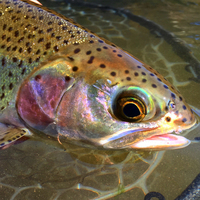What do Trout See & How To Exploit it When Fishing
Posted by Peter Stitcher on 2nd Apr 2014
Sitting alongside the river in the morning and surveying the spread of fly boxes that surround me, each with closely-packed ranks of flies, I feel like a general inspecting his troops before battle. At this point, I face the perpetual question of which fly to deploy to outwit my foe, the trout. Before I make a selection, I look at the terrain (elevation, habitat, and cover) and the conditions (temperature, flows, and weather) and attempt to determine which invertebrates are present in, on, and around the water. While you will rarely go wrong by attempting to match the size, profile, and color of the naturals, if we want to take fly selection to the next level, we need to try to understand how fish view the fly. In the words of Sun Tzo in The Art of War, "to know your enemy, you must become your enemy."
The eye of the trout is a highly developed organ that can perceive and track food by three means: Motion,Contrast, and Color. The realistic motion given to the artificial fly is the most important factor in attracting a trout to your rig. From our first day on the water with a fly rod in hand, we have had the mantra of "drag free drift" drilled into our consciousness. It is important to understand how a free-floating nymph behaves in drift, how an adult stonefly will skitter across the surface of a pool, and how a sculpin will dart and pause as it seeks to elude a predator. Trout can both "feel" these movements through their lateral line, and track them with their eyes. In the ever moving and flowing world of trout, realistic motion is key to drawing the trout in.
Trout are uniquely engineered to be able to detect contrast. Whether it is the shadowed body of a dry drift against a bluebird sky, or a black beauty midge drifting among granite boulders, a contrasting element tied into your artificial fly helps to make it pop out to trout. Silver wire over black, brass beads next to peacock herl, or a dark foam body used to float a dry put trout in attack mode! Contrast is the second-most important element in trout vision and is of particular importance when fishing at night. Trout are not interested in counting the number of tails on your nymph imitation, but if it has the general profile of a natural and offers some contrast to its surroundings, get ready to set the hook!
The final element in trout vision is their ability to discern color. The eye of the trout can detect four spectrums of light: Red, Green, Blue, and Ultraviolet (this spectrum fades out at two years of age). Before you start tying all of your caddis in red, it is important to understand that light behaves differently in water than in air. In perfectly clear water, all red wavelengths are absorbed so that it appears black to a trout, while blue remains visible to a depth of 60 feet. This fading to black is also true on a horizontal plane, so that a fly needs to be fairly close to a fish for its full brilliance to be viewed.
So, let us approach the water ready for battle this spring! Perfect your drift, focus on contrast within your patterns, and try utilizing more purples and blues to penetrate murky spring waters.


